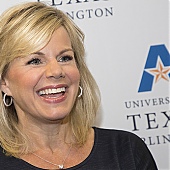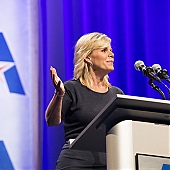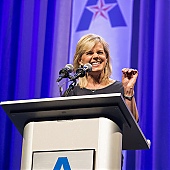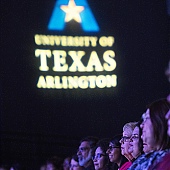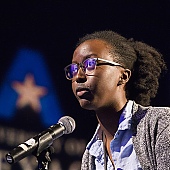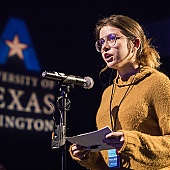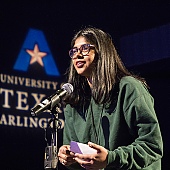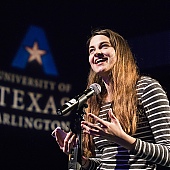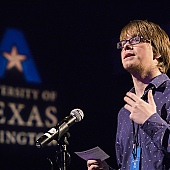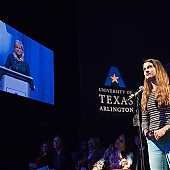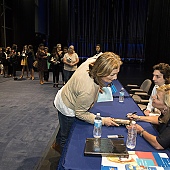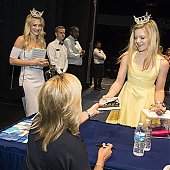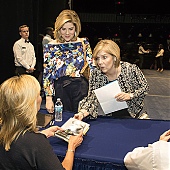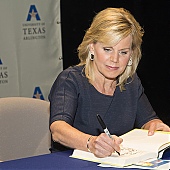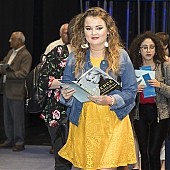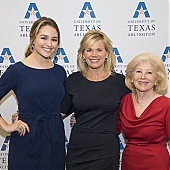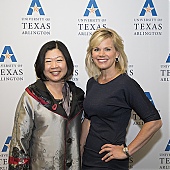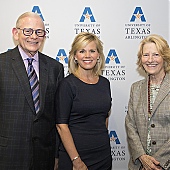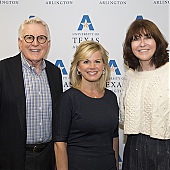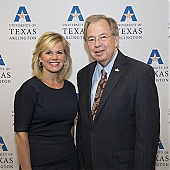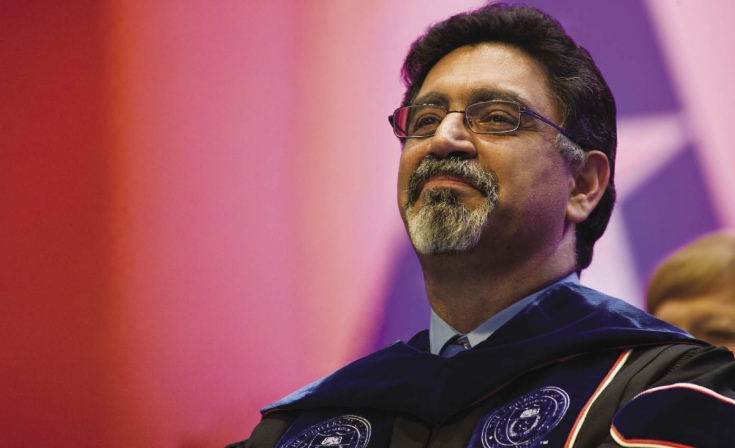
Sharing a Bold Vision
Vistasp Karbhari hit the ground running in June as UT Arlington’s eighth president. The focused and energetic leader is determined to guide the University to new levels of excellence.
Lofty goals don’t daunt Vistasp Karbhari; they motivate him. One conversation with UT Arlington’s new president and you’re inspired by his resolve to help the University scale peaks that once seemed unattainable. In his eyes, great isn’t good enough. He wants UT Arlington to rise, rapidly, into the upper echelon of research institutions. He wants the University to become internationally recognized as a leader in scholarship, educational access, and community engagement.
In short, he wants UT Arlington to become Tier One—not only by the state-defined metrics, but by achieving pre-eminence as an academic institution. He believes that by focusing strategically and collaboratively, the University can reach this goal sooner rather than later.
“Let’s dream together, work together, chart new directions, and attain levels of excellence that others did not even dare to dream of,” President Karbhari told a gathering of alumni shortly after taking office. “UT Arlington is destined to be the model 21st-century urban university. Let’s make it happen together.”
UTArlington Magazine caught up with the University’s eighth president for a conversation about how he plans to lead the way.
What have you learned in your first few months on the job? I’ve learned a lot. What’s very apparent is that we have a tremendous reputation that’s well deserved. There is a great appreciation for where we are and the distance we’ve come in the last three to five years. A great deal of enthusiasm and excitement exist for taking the next steps to go from being a great university to being a pre-eminent university.
What attracted you to UT Arlington? A few things stood out. I believe education is at a crossroads. There are research powerhouses that churn out tremendous research. There are very good educational institutions that perhaps do not do as much research as they could. Then there are universities in-between that are trying to figure out whether they’re going to be one or the other. Very few in these groups have figured out how to balance excellence in teaching and research, and UT Arlington is one of those.
LEADING THE WAY
Vistasp Karbhari says the model 21st-century urban university is one that balances the need to be a scholarly institution with the need to be an economic, social, and cultural driver for the community and region. He believes UT Arlington is positioned to do just that.
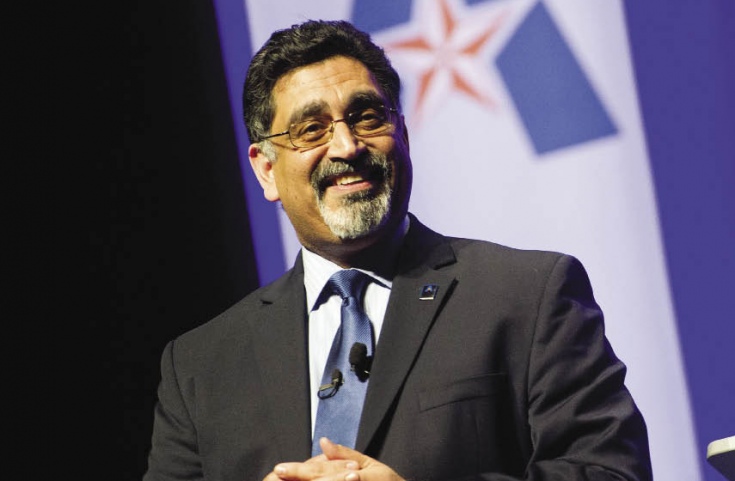
There is a balance between scholarship, educational access and excellence, and strength in research. UT Arlington is an institution that’s positioned in a thriving region. For a university to be viable in the 21st century, especially in an urban setting like ours, it needs three things. First, it needs to have a strong educational program both for the generation and transfer of knowledge and for workforce development. Second, it needs to have tremendous support within the community and a very strong link to the community and the larger region. And third, its research should not just be in fundamental areas but also in areas of applied and translational research.
All of these things taken together are what attracted me here, as well as the opportunity to work with a great team that is dedicated to reaching that next level.
To many, the next level means becoming a Tier One institution. What’s your interpretation of Tier One? Tier One is a notation people use in a variety of ways. As defined by some, it has a narrow connotation, not a bad one, but narrow. There are boxes that have to be checked off. You need $100 million in research expenditures, 200 Ph.D. graduates, and the list goes on. Those are necessary conditions but not sufficient ones.
Tier One could mean being classified by the Carnegie Foundation for the Advancement of Teaching in the Very High Research category. We are currently in the High Research category. It could mean being listed in the top 50 or 100 universities by the Center for Measuring University Performance. Right now we’re in the top 200. It could mean being a member of the Association of American Universities (AAU), which is a very select organization by invitation only.
“A great deal of enthusiasm and excitement exist for taking the next steps to go from being a great university to being a pre-eminent university.”
But to me, Tier One is not specifically any of those. It’s being a university that is pre-eminent in its chosen domain. It has to have a high level of research expenditures. It has to have the large number of top-notch programs. It has to have the graduate students. But we also must have excellence across the board. Tier One to me means being able to balance the excellence in research with teaching. It means being a place where our students, staff, and faculty are at the top of their games in scholarship and creative activity. It means being in the upper echelon in terms of reputation in all areas.
How close are we to being Tier One? By some measures, we’re already there. If you look at the recent accolades we’ve received, one could argue that we’re on par with other Tier One institutions. In May the New America Foundation described UT Arlington as a “Next Generation University”—one of only six in the nation. In August The Chronicle of Higher Education ranked us as the seventh fastest-growing public research university in the United States. The U.S. News & World Report rankings released in September listed us as the fifth most diverse among national universities. By these measures, we are competing with universities that are already Tier One. But we haven’t checked off all the boxes, and there’s a lot we still need to do.
How do we reach Tier One in other areas? Strategic planning is number one. We must choose from all of the wonderful opportunities in front of us. That will be one of the biggest challenges that we as a university face. We have so many opportunities to excel, but we can’t choose all of them at the same time. We will pick key ones in a strategic manner. We have to figure out ways to attract and retain more of the best faculty. Many of our faculty are world-renowned, but we need to build up critical mass in specific areas. We also need to focus more on interdisciplinary and cross-disciplinary research and education.
If strategic planning is number one, is private philanthropy a close second? It’s hugely important because strategic planning and philanthropy are so closely connected. Philanthropy helps fund the plan. It is becoming more and more expensive for students to access education. There is tremendous competition for the best faculty. If we are to give the best education to our students, we want the best faculty. We need the latest technology and first-rate facilities to give greater access, to bring more knowledge, and to improve research and teaching. All of this costs money. Private philanthropy becomes immensely important for us to satisfy these demands and reach these aims because such a small percentage of our funding now comes from state and federal sources. It is absolutely essential if we are to continue to do all of the great things we are doing, as well as to fund all that we aspire to do—not just to be Tier One, but to truly fulfill our mission.
You’ve said UT Arlington is poised to be the model 21st-century urban university. What does that model look like? It’s a university that is intrinsically linked to the well-being of the community. It’s not just a university that excels at scholarship, but a university that provides access to students at all levels. We need to be the hub and a great partner. We’re the intellectual heart of the community. As we look at the model 21st-century university, it is the one that can balance the need to be a scholarly institution with the need to be an economic, social, and cultural driver for the community and region. UT Arlington is positioned to do just that. We’re already doing so much of it. If we did a little bit more, we’d be setting the standard for everybody.
“We must make sure that we’re able to give any student who has the desire, motivation, and qualifications access to the tremendous knowledge that exists here.”
Why is a strong community connection so important? Community engagement must be a priority. You can define a public university’s mission in a variety of ways. It’s education beyond the classroom, being able to take the expertise and knowledge one might have and doing good with it, spreading that knowledge to where it might be of most benefit. Community engagement is an important part of it. We need to continue to be an intrinsic part of this community.
What role does athletics play in the fabric of UT Arlington? It plays a big role. Athletics is one of the few things that brings a university together, that creates pride and school spirit. Most people aren’t going to sit in a math class and say, “Wow, this is why I came to UT Arlington.” But a large group of students could be at our games, cheering on our athletes and feeling proud, not just of the team but that we’re all Mavericks. Athletics brings people together and builds spirit so that after students graduate, they maintain lifelong ties to the University.
How would you describe your leadership style? It’s very collaborative but with very high goals and expectations. I truly believe that most of us are at the University because we want to make a difference. We want to do something that would not have been possible elsewhere. I’d like to enable that to happen, to move everyone forward as a team so we can achieve what others thought was unattainable.
What are your hobbies? I love to go on walks with my dog. I love to try new food. I love to read, I love music, and I love to travel. I also love to meet people, and I’m enjoying meeting our wonderful alumni and supporters in the community.
What’s the source of your strong belief in the importance of education? My parents made sure we understood that education was very important, not just for the sake of getting a job but for the sake of understanding where we were, who we were, and the world around us. Today more than ever it’s imperative that we know about topics much broader than our area of expertise.
Did your parents go to college? Yes, they did. I’m very fortunate in that sense. I grew up in a family that had books all around. I read books on art and literature when I was very young. I probably read Shakespeare by the time I was 7 or 8. Both of my parents did a lot to make sure that I am where I am today. They instilled in me a lot of the qualities that I have and the goals that I aspire to achieve.
STUDENT FOCUSED
In his first months on the job, President Karbhari attended the University’s annual Move-In Day, left, and interacted with students in a variety of settings. The visible and approachable leader meets with students individually and in groups as much as possible to answer questions and talk about the excellence at UT Arlington.
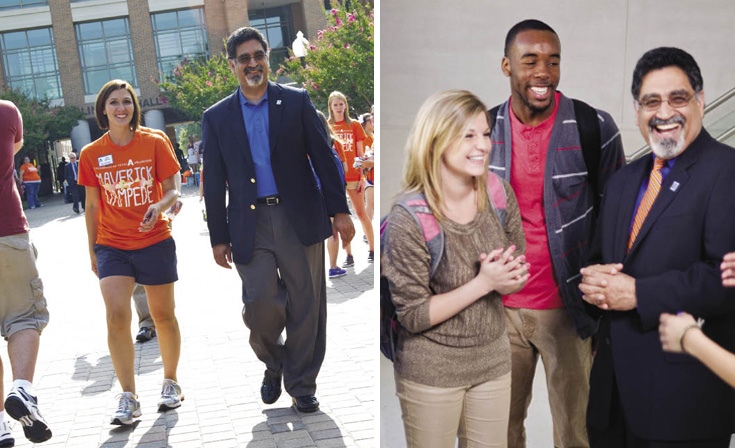
Why did you come to the United States for your Ph.D.? When I started looking at the United States, I had finished my master’s degree in structural engineering at the University of Poona. I was working in one of the largest engineering consulting firms in India and was looking for a new challenge. Two areas stood out. One was failure analysis, looking at the reliability of structures and trying to understand why they failed. The other was a new type of material—composite materials. They were developed to fix some of the problems with other materials as well as make them lighter and stronger. At the time, the University of Delaware hosted the National Science Foundation Center of Excellence in Composites. It was the only one in the United States.
What do you consider to be UT Arlington’s primary strengths? We have a tremendous strength in faculty and staff who are dedicated to the institution. It’s not just a job for them. They’re here because they love it. They love to give back to the students. The other is our ability to be Mavericks, to dream and do things that others might not have done before.
What are our biggest challenges? We must pick the right opportunities and have the patience to work through them a few at a time rather than all at once. We need to energize our alumni base and our friends in the community so they are motivated to invest in the University—to provide the private philanthropy that is so essential to help us reach that next level. We must make sure that we’re able to give any student who has the desire, motivation, and qualifications access to the tremendous knowledge that exists here.
Why is it important to balance research and teaching? One feeds the other. If we only do research, by definition we’re not a university. We would be a research institute or an R&D center. If you only teach and your faculty are not engaged in discovery and inquiry, you’re getting stale knowledge. The ability to engage in research, creative activity, and scholarship at their highest levels keeps faculty at the forefront of their disciplines. But it also shows our students how you can find new knowledge and accomplish something that many thought was not possible. When faculty discover something new, that experience can change students’ lives. It also changes the way our students think. It instills in them creativity and innovation. So if we have one without the other, we’re not able to provide the best education for our students.
What’s your pitch to a prospective UT Arlington student? We have a tremendous university with a depth found at few others. We have faculty and staff who truly care about you. You are not a number; you are a face and a name. We are dedicated to your success. Our faculty bring a wealth of research expertise.
For students who come here, especially at the undergraduate level, an important consideration is what they do after they get a degree. Obtaining knowledge for the sake of knowledge is not enough. Harsh reality says we need jobs. Because of the number of alumni, our geographic location, and our reputation, getting jobs is far easier here than at many other locations. Students have a wonderful experience here. Then they graduate with knowledge and experience, perhaps through internships or summer jobs. The career prospects with a degree from UT Arlington are tremendous.
Along the same lines, what do you say to a faculty member considering a move to UT Arlington? For younger faculty members in the early stages of their careers, this is a tremendous place to build a career—a great place to make a name for themselves, hit their stride, and stake a claim in their field. The academic environment here is vibrant, collaborative, and supportive, and the region will continue to grow exponentially during the coming years. Likewise, for a tenured faculty member who has achieved success and built a reputation at another institution, UT Arlington is a wonderful university to embark on the next chapter in teaching, scholarship, and intensive research. Whatever the case, new faculty members will find welcoming colleagues here who are eager to work together to explore new ideas and chart new territory. Whether it’s an individual faculty member who’s joining us or an entire team of faculty and doctoral students, this is the place to find success and make great things happen.
In one of your speeches, you said UT Arlington stands on the brink of greatness. What pushes us over the top? Greatness comes to a university that has done enough to separate itself from all its peers. We have separated ourselves from some of our peers. We’re at the brink of doing much more. Leading in terms of online education, having faculty who teach and do research at the cutting edge of their disciplines, being so intrinsically tied to the community that we drive the well-being of the community—it’s doing more of these things. We don’t have to start from scratch. We’re almost there.
How will you develop your vision for the University? It’s a vision that has to be developed in concert with our constituencies. I’ve been talking with and listening to a lot of people. I’m trying to better understand the excellence that exists here. Step by step, I’m visiting with our faculty and staff, talking to different people, including students. I’m talking to people in the community, starting with the mayor and other leaders, trying to determine what makes this university tick, why it is so special. I will use all of this information so that our dreams and hopes are combined in that vision. It can’t be just my vision. If it’s just my vision, it’s not a vision for the University.
In your opinion, what does it take to be a successful university president? Success can be defined in many ways. I think presidents would be considered successful if, when they left, the university was significantly better than when they arrived. Did they facilitate the growth of the excellence that exists in the faculty, staff, and students? Did they facilitate new opportunities for students and the ability of more students to access a greater amount of knowledge? Did they enable the community to feel a greater kinship with the university? Did they help alumni feel a true sense of pride? I think if presidents can do all that, then they have been successful.
Is your priority elevating UT Arlington to Tier One status? I think that’s too narrow a focus. It is a priority, but it cannot be the only priority. Tier One is a journey. If we hold the end goal as being our only priority, then we lose sight of everything else. We will definitely focus on the Tier One metrics, but the journey is also valuable. The journey must balance excellence in teaching and research, access to education and knowledge, and the development of new knowledge.
What message do you have for alumni and other supporters of the University? Feel proud of being a Maverick. Come back and visit. Come see things that may not have been here when you were students. Join us on this wonderful journey. We can’t succeed without our alumni.
There are many ways they can assist us beyond just having pride. One is obviously providing resources and philanthropy that will make it possible to reach our goals faster—to hire and retain the best faculty, to provide access for more students, to have the best facilities that enable us to educate and conduct research. Alumni can also provide a network for our students. They have a tremendous influence on who comes to The University of Texas at Arlington and how those students succeed in life. They are able to mentor students, give them career advice, facilitate internships, and provide a network that helps them get jobs when they graduate. If all of our nearly 170,000 alumni did that, we’d be doing wonderfully well. I want them to be part of where we’re going.
Any final thoughts? I’m excited and very, very enthusiastic about where UT Arlington is headed.
Read about President Karbhari’s wife, Lisa, in Indelible Impact.
